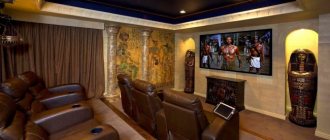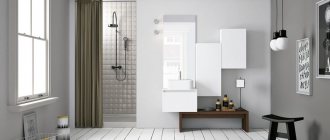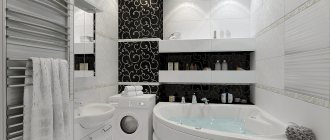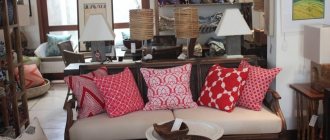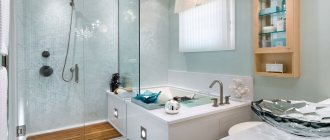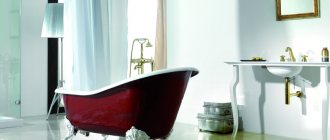Moroccan style is truly exotic for Russian people. Of all the styles, it is probably one of the most recent to remember. In addition, its unpopularity in our country is caused by the high cost of execution. But if you have decided to use it in the interior of your bathroom, then you can be one hundred percent sure that there is nothing similar in the area that could compare with the result of your work.
Main features
The calling card of the style and the first thing that comes to mind for those who are at least a little familiar with the culture and architecture of the East are complex oriental patterns and equally complex arches . It is these two features that are used in the Moroccan interior not only to decorate doors, windows and walls, but also to decorate internal partitions. Surprisingly, with all the abundance of patterns, the Moroccan interior does not seem overly overloaded with them. The same applies to arches, which are everywhere, but do not seem superfluous. And in any Moroccan interior there is always a vaulted niche, richly and beautifully decorated.
If you have already become quite familiar with the Moroccan style, then you have probably already thought that its embodiment in our small bathrooms is practically a utopia. Even combining it with a toilet will not bring any benefit. However, nothing is impossible, and a way out can be found in any situation.
Moroccan palette
Natural cold and warm shades are evenly present in the Moroccan style, without competing with each other. The base is most often neutral:
- sand, beige, ocher;
- bronze, burnt umber, dark brown;
- white.
Natural cold and warm shades are evenly present in the Moroccan style, without competing with each other
Tones such as:
- blue in shades from turquoise to dark blue;
- green, primarily emerald, ultramarine;
- violet;
- red, including scarlet, fuchsia;
- black.
Important! Overall, the color scheme of the Moroccan style gives the impression of a positive and cheerful space, without overloading the perception or tiring the eyes.
Avoid counterfeiting
Moroccan style is extremely beautiful in every detail and requires a competent and carefully thought-out approach. Cheating is strictly prohibited here. No cheap imitations or replacements can be made, otherwise there is a risk of not only not falling into style, but also creating something like a pathetic parody.
For example, plastic curtains on plastic curtain rods look extremely poor due to their cheapness and primitivism. Wooden partitions are what should divide the bathroom into parts or separate the bath from the rest of the area, but not a cheap film curtain. Yes, and the cornice should be metal and all with the same openwork.
In no case do not forget about mirrors, lamps and carvings in principle - all these elements significantly enrich and saturate the interior. There should be no emptiness here, this is a luxury style that does not tolerate inaccuracies.
When decorating walls and floors, use small tiles or mosaics, but not pieces of tile assembled like a puzzle. Such rudeness will look extremely inappropriate and cheap.
If you do not have sufficient funds to create an ornamental Moroccan style, then you can easily create a bathroom in a natural Moroccan version. It will cost much less, and not only a team of brilliant workers, but also ordinary hard workers will be able to finish such an interior with high quality. As a result, the atmosphere of the East will settle in your bathroom for many years, and you will be able to touch the Arabian fairy tale.
Geometry Features
A Moroccan-style bathroom will become recognizable thanks to some design elements that are easy to implement even in a small space. One of them is an arch. Narrow and wide, horseshoe-shaped and lancet arches are used to design not only door or window openings, but also for cabinet niches, mirrors, shower stalls, and bathtubs. Even a modest arched niche for a hanger looks appropriate in the interior of this style.
A Moroccan-style bathroom will become recognizable thanks to some design elements that are easy to create even in a small space
Niches of different sizes complicate the geometry of the space, creating the intricacy necessary for oriental design, while the bathroom receives not only exquisite decor, but additional space. It is most convenient to use moisture-resistant plasterboard to construct arches and niches. Sometimes niches and arches are highlighted with mosaic decoration along the contour.
Another opportunity to emphasize the eastern orientation of the interior is to make the ceiling domed or designate vaults; plasterboard will again help with this
Another opportunity to emphasize the eastern orientation of the interior is to make the ceiling domed or designate vaults; plasterboard will again help with this.
Features of African style
The general concept of “African-style bathroom” includes the use of cultural and ethnic elements from countries such as Egypt, Tunisia, Algeria, Morocco, Chad, Nigeria, Kenya and many other countries of this tropical continent. Each culture has distinct characteristics, but at the same time they are very similar to each other.
A Moroccan-style bathtub has gained particular popularity due to the fact that it successfully combines African and Arab cultures at the same time, which at first glance seem completely different and incompatible.
Finishing the ceiling, walls and floor
In the Moroccan style, naturalness is encouraged, so the ceiling can simply be plastered and painted with waterproof paint in a neutral shade. If you have a sufficient budget for repairs, you can decorate the ceiling with stretch film with a pattern or carved wooden panels. The panels must be treated against rot and fungus; the presence of treatment is usually confirmed by a certificate.
In the Moroccan style, naturalness is encouraged, so the ceiling can simply be plastered and painted with waterproof paint in a neutral shade
The main focus is on the wall covering. In this capacity it is used:
- a rough layer of plaster coated with paint, imitating an adobe building;
- decorative plaster with a glossy effect creating the appearance of marble walls;
- large ceramic tiles with oriental patterns;
- small glossy mosaic up to 4x4 cm in size;
- ceramic cubes measuring 2x2 cm, which are traditionally called zelij;
- combined option.
To create a Moroccan style, tiles with traditionally oriental patterns are suitable, among them geometric patterns predominate (octahedrons, stars, rhombuses, squares). Such tiles are connected to each other according to mathematical rules, not chaotically. Tiles with a floral pattern look beautiful.
To create a Moroccan style, tiles with traditionally oriental patterns are suitable, among them geometric patterns predominate (octahedrons, stars, rhombuses, squares)
Moroccan tiles in the patchwork style look especially interesting. Selecting tile patterns on your own is quite difficult; it requires impeccable taste, so among the collections of ceramics you can choose ready-made versions of various patterns in a variety of colors.
By combining a plastered surface with ceramic inserts, you can get an interesting interior in which some areas (near the sink, shower) are highlighted with bright tiles.
Traditionally, in Morocco, floors are covered with stone tiles, which keep the room cool, but in domestic bathrooms it is necessary to first install a “warm floor” system
A frieze made of carved wood is installed at the junction between the ceiling and walls.
Important! Plastic products are inappropriate in a Moroccan-style bathroom.
Traditionally, in Morocco, floors are covered with stone tiles, which keep the room cool, but in domestic bathrooms it is necessary to first install a “warm floor” system. To save money, porcelain tiles, which have excellent decorative and functional qualities, are often laid on the floor.
Trying to fit into the frame
To recreate the atmosphere of the fabulous East, let's try to start with a traditional arch. It can be made of plasterboard and covered with waterproof paint with a satin or silk effect. Instead of tiles, mosaics can be used to decorate such an element.
It will cost more, but at the same time the move is strong, and you will be more than one step closer to style.
If you want to use the usual ceramic tiles for decoration, then remember that the Moroccan style accepts the use of tiles of a maximum size of only 15x15cm with a pronounced oriental pattern. Moreover, ornaments, drawings and Arabic script are used in the bathroom everywhere you can imagine.
The complexity and exoticism of the Moroccan style lies not only in the patterns, but also in any details such as plumbing fixtures of unusual shapes, which are truly exclusive. That is why few people can afford such a style in their apartment. However, it is not always necessary to follow the Moroccan style rule of purchasing expensive interior items. You can often find much cheaper analogues that will fit into the space just as well.
For example, a sink can be quite varied in design, shape, color and design, so you will have the opportunity to choose from the model ranges something that is most suitable and fits your budget.
Features of the appearance of plumbing fixtures
In various photographs, a Moroccan-style bathroom immediately stands out due to its unusual design forms of plumbing fixtures. Since ancient times, Moroccan baths have been equipped with large round pools, sunk into the floor and lined with fine mosaic tiles.
Therefore, it is better to opt for a round or semicircular bath or shower. Ideally, the bathtub will be deepened, and you need to climb several steps to reach it.
Ideally, the bathtub will be deepened, and you need to climb several steps to get to it.
The sink should be preferred:
- round or oval shape;
- made of copper or bronze alloy, stone or successfully stylized as them;
- decorated with oriental ornaments;
- built into a table or one that is placed on top like a bowl.
It’s great if the sink evokes associations with traditional oriental bowls for washing hands, then the choice was made well.
If you plan to place a washing machine and dryer in the bathroom, it is better to hide them from view using niches or decorative protrusions. Modern technology does not harmonize well with ethnic styles, which include Moroccan.
Character of style ↑
The style received its name from the country of Morocco, which is famous for its originality and uniqueness. It is unique in its cultural heritage and has given designers enormous scope for imagination and ideas. Moroccan style is characterized by a bold mixture of colors and textures of materials. In a modern Moroccan interior, complex ornaments of local peoples, the style of nomads, bordering on rudeness, and European finishing materials and furniture coexist perfectly.
Tiling a Moroccan-style bathtub is not an easy task. But the effect is definitely worth it
Conventionally, Moroccan style can be divided into two main directions: Spanish-Moorish (or Andalusian) and Berber. The Berber style is simpler and much rougher in execution. It will be significantly different from the luxurious Spanish-Moorish interior. This happens because the culture of the Berbers still remains at a primitive level, where the tasks of utilitarianism dominate; even the trends of civilization penetrating into the depths of this people cannot change the usual way of culture.
An important part of the interior is accessories
A Moroccan-style bathroom (the photos in our article offer different design options) is necessarily decorated with textiles and trinkets. The effect is achieved not by the number of accessories, but by their correct selection and placement. What is needed to create the authentic spirit of Morocco:
- Textile. If the bathroom has windows, great; they can be covered with thick textured curtains. Using waterproof fabric with oriental patterns, it’s easy to make something like a tent around a bathtub or shower stall. A woven drapery separating a hanger or a place for a washing machine will also decorate the room. Rugs with ethnic patterns look great on the floor. Towels and bathrobes must be selected to match the color scheme of the room.
- Mirror. A round or oval mirror is framed in a wooden or copper frame; a fine ceramic mosaic edging is suitable.
- Lighting. You can create a style using just one bright touch - Moroccan lanterns. Slightly elongated bowl-shaped lamps are made of copper and decorated with carvings and colored glass inserts. Such lamps are hung on fairly thick, strong chains, either singly or several in a row. 1-2 wall lamps or candlesticks made of forged metal in black or bronze color fit perfectly into the bathroom interior.
- Furniture. A small amount of furniture is usually used in the bathroom, but if the size of the room allows, a low ottoman or a couch with many pillows would look appropriate. This sofa immediately creates an atmosphere of oriental bliss and luxury.
Select furniture items (including a wardrobe or chair) from dark-colored wood, preferably cedar, beech or thuja
Select furniture items (including a wardrobe or chair) from dark-colored wood, preferably cedar, beech or thuja. The shape of the products is rectangular, slightly elongated, on strong legs. Decorate bathroom furniture:
- forged elements;
- carving;
- mother-of-pearl inlays;
- mosaic inserts;
- hand painted with ethnic motifs.
Moroccan style looks exotic and at the same time cozy, it does not become boring and does not go out of fashion, so it is great for decorating a bathroom
Moroccan style looks exotic and at the same time cozy, it does not become boring and does not go out of fashion, so it is great for decorating a bathroom.
Furniture in Moroccan style
A bathroom decorated in African style may have many niches in which figurines, vases or lamps are installed. If you follow the Moroccan style and adhere to all its ethnic trends, you should pay attention to windows and doors. It is better to use an arched design, as it is typical for all southern regions of the continent.
A tropical themed bathroom can be made using inexpensive woods as well as handcrafted items adorned with Arabic designs with precious stones. Stools and chairs have a soft base made of rough fabric in dark shades.
One of the mandatory conditions in interior design can be considered the presence of forged elements. You can use stands, shelves or furniture fittings.
Many designers, in the process of creating Moroccan style, use old products and remake them to meet new requirements. Furniture can be treated with stain to obtain the desired shade. Very often, countertops are decorated with mosaic tiles, which perfectly complement the design.
Interior decor ↑
Metal is an integral part of the Moroccan interior. These can be forged black bars on tall narrow windows or in arches that imitate them. To decorate the room, objects made of bronze or chased silver are necessarily used. Thus, additional texture is introduced into the interior. These can be various candlesticks, lamps or candelabra. However, the number of such bright accessories should be small, otherwise the design will lose harmony.
The highlight of the interior can be a painted sink.
Plumbing equipment decorated with oriental-style paintings and furniture inlaid with mother-of-pearl, echoing metal lamps, will look good. The finishing touch is a mirror, perhaps even several. Then they are used to build a composition on the wall. You can give your bathroom the recognizable features of a hammam, because it is not only a Turkish bath, but also a Moroccan one.
Unity of simplicity and luxury
Textiles and accessories are of particular importance in the Moroccan interior. Textiles generally play a fundamental role in the interior of the Moroccan style, so it abounds in large quantities, in the form of embroidered pillows, multi-layer curtains and, of course, carpets that will create comfort and peace. Naturally, we cannot fill the bathtub with pillows and carpets. But, for example, you can choose a fabric curtain for the bathroom instead of a plastic one. If you have a window in the bathroom, ditch the blinds in favor of soft curtains. Even the usual towels and rugs that are always present in the bathroom can complement the interior. Carved or hand-painted furniture is quite popular and loved. To give the interior more color, I use all kinds of figures and figurines inlaid with cupronickel, glass or leather.
Moroccan style loves details. After all, unity consists of little things

